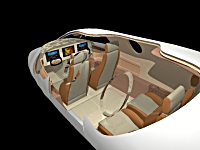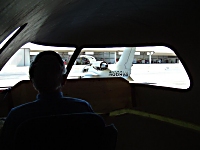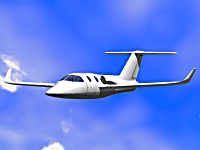New Very Light Jet Challenges Quest for Insurability
| |
 | |
 | |
 | |
 | |
 |
Apr. 21, 2004 - Squarely addressing the issue of insuring owner-pilots in very light jets, Excel-Jet Inc. of Monument, Colorado, is proceeding with development of the Sport-Jet, a four-place pressurized airplane powered by a single turbofan in the 1,350-pound class such as Pratt & Whitney's PW615 and Williams International's FJ-33. Major features of the aircraft were selected to achieve a high level of safety for the typical owner-pilot who wants a jet but currently is operating a sophisticated single, light twin, or turboprop, according to Bob Bornhofen, Excel-Jet's president.
"We want jet-engine reliability and ease of operation as well as the simplicity of one engine. Using the latest in advanced avionics, we will provide the pilot with excellent situational awareness. Our initial rate of climb will be 2,500 feet per minute, and we will certify for a maximum altitude of FL250. These parameters will enable the Sport-Jet pilot to climb quickly above much of the weather, yet avoid many of the issues and unknowns associated with owner-pilots operating where the physiological effects of pressurization loss are more significant. The Sport-Jet will have a ballistic parachute system for two reasons - for occupant protection in the event of a catastrophic mishap and for loss of control such as a spin. We have purposely selected a four-seat configuration to limit exposure to liability claims," said Bornhofen.
Excel-Jet plans to introduce a full-size mockup of the Sport-Jet as well as examples of major components for the first flying article at this year's EAA AirVenture. The aircraft's cabin will be constructed from composite materials as will the wing/fuselage attachments. Outer wing panels, tail, and empennage will be aluminum. Considerable attention has been directed to ease of maintenance and repair. For example, Bornhofen elected a wingspan of 33.2 feet consisting of replaceable wing panels and a wing-mounted landing gear for quick replacement of components in the event of hangar damage or a mishap during landing. Overall length of the aircraft is 29 feet, with a maximum tail height of 8.2 feet. The aircraft may also feature a specially designed in-flight data recorder to track performance and assist a pilot in obtaining the best results from the Sport-Jet.
Bornhofen, 59, holds a BS degree in aeronautical engineering from Parks College as well as an MS in aerospace engineering. He was an engineer with NASA's Apollo space program and worked with military satellites before venturing into the design and manufacture of large-format digital copiers. Upon selling his copier business, Bornhofen moved into aircraft design to fulfill his passion for aircraft and flight. His first efforts were directed at the Maverick Twinjet, but that program was sidelined as attention was shifted in 2003 to the Sport-Jet.
First flight of the Sport-Jet is planned for later this year, with certification anticipated two years later. The aircraft is expected to have a maximum speed of 375 knots and a stall speed of 68 knots. Normal and economic cruise speeds are 350 kts and 310 kts, respectively, according to preliminary specifications. Airport performance is projected to be 2,300 feet for takeoff and 1,800 feet for landing. With an empty weigh of 2,900 pounds and a maximum takeoff weight of 4,900 pounds, the Sport-Jet should have a range of 1,000 nm with a fuel maximum fuel load of 210 gallons.
"We have held discussions with insurance experts, such as Bill Behan at AirSure Ltd., located in Golden, Colorado, and we are confident that the Sport-Jet offers features that will add to its insurability," concluded Bornhofen. - John W. Olcott
Posted Wednesday, April 21, 2004 11:25:36 AM


